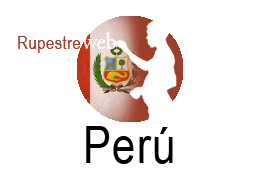
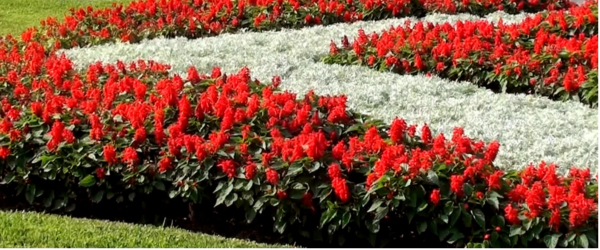 |
|---|
Figure 1. Contrasting flower beds of the Plaza Mayor in Lima, the
capital of Peru.
|
Interestingly however, much of the petroglyph art in
this part of the Andes features (rather: featured) the same contrasting
colours, surprisingly at micro level and at macro level. Importantly, in the natural landscape the contrasting colours
hardly ever are pure white and true red. Nevertheless, for matters of
convenience I will still use the terms ‘red’ and ‘white’ throughout the text,
but it will become clear that mainly the contrast between darker colours (for
instance black, red, purple, brown) and brighter colours (white, yellow, grey)
is decisive.
The Archaeological Context
The valleys of the Río Sechín and adjacent Río Casma
(Figure 2) are famous for especially its Formative Period archaeological
monuments. About 20 km SE of El Olivar is the complex of Formative Period
monuments of - among many others - Cerro Sechín, Sechín Bajo and Sechín Alto
and several other ancient structures, many of which are lavishly decorated. The
zone near El Olivar (Figure 3) is less well documented but features as well
many prehistoric ruins that to my knowledge have not yet been excavated. About
1.5 km to the north of the petroglyph site and located on the floodplain of the
Río Sechín (10 in Figure 4) and on the edge of the hamlet of Olivar Bajo (at
340 m O.D.) are the remains of Huaca de
El Olivar (6 in Figure 4), while 760 m to the SE is a possible Tambo (resting place) (11 in Figure 4).
Opposite the Huaca de El Olivar the SE facing hill slopes of the Sechín Valley
are littered with prehistoric structures and terraces (7 in Figure 4),
indicating the significance of this particular zone in prehistoric times.
Another important archaeological feature confirms the key position of this
area. This feature will be discussed further below.
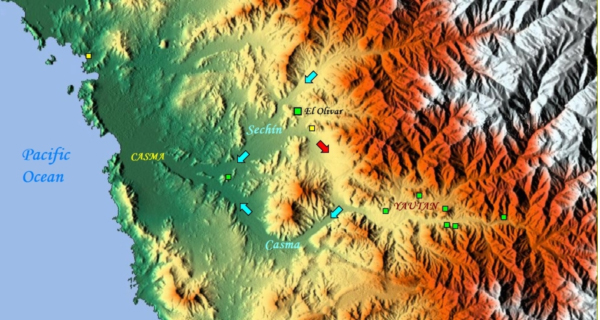 |
|---|
Figure 2. Map showing the location of the El Olivar petroglyph site in
the Sechín Valley, Ancash, Peru.
Green squares: rock art sites; yellow squares: geoglyph sites. Map © by Maarten van Hoek, based on Google Earth Relief Maps. |
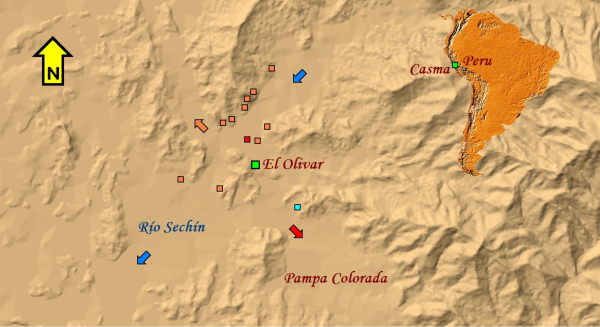 |
| Figure 3. Map showing the location of the El Olivar petroglyph site in
the Sechín Valley, Ancash, Peru. Map © by Maarten van Hoek, based on Carta educativa de las Direcciones Regionales de Educación y Unidades de Gestión Educativa Local. (Ugel_Casma.PDF). |
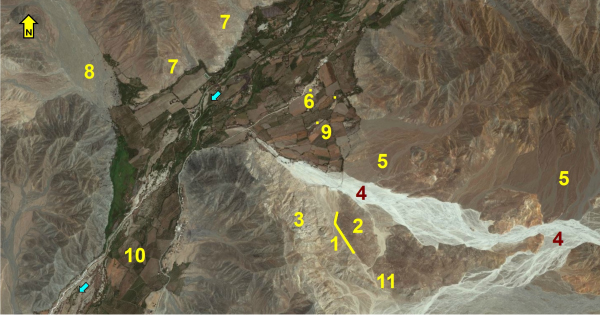 |
Figure 4. Detail map showing the location of the El Olivar petroglyph
site (1) in the Sechín Valley, Ancash, Peru. Further
explanation in the text.
|
El Olivar is a small petroglyph site near the valley
of the Río Sechín (Departamento de Ancash
/ Provincia de Casma / Distrito de Buena Vista Alta), located roughly 25 km
inland and about 2 km SE of the river Sechín (Figures 2, 3 and 4; see video).
The site is located in a typical Andean desert landscape. There is a very sharp
contrast between the lush, fertile river valley and the barren desert that
immediately borders the valley. From (near) the site spectacular vistas of the
surrounding mountains can be seen, especially to the east (Figure 5; see
video). There is no vegetation at the site of El Olivar. Only in the dry river
bed of the Quebrada Tucushuanca (to the north of the site), isolated low trees,
some scrubs and scrubby vegetation occasionally occur. Because of the rare
torrential downpours (possibly caused by El Niño’s) this vegetation only
survives at the borders and somewhat higher places. Also, at several places
deep gullies have been carved out by such downpours south of El Olivar (Figure
6; see video).
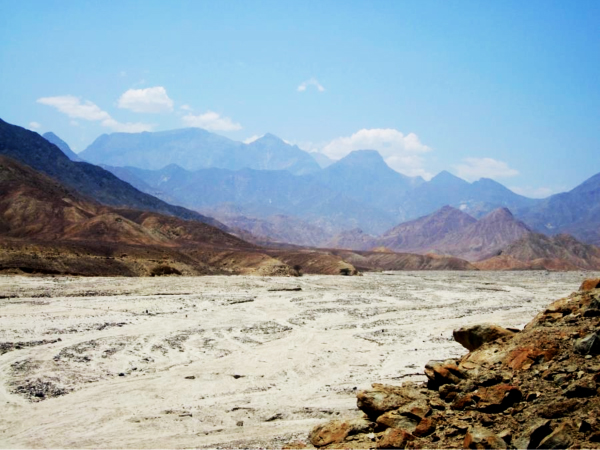 |
|---|
Figure 5. Looking east across the dry river bed of Quebrada
Tucushuanca (4 in Figure 4)
|
El Olivar es un sector del distrito de Buenavista Alta, que dista unos 5 kilometros en la carretera que va hacia Quillo, en donde se encuentran un sin numero de dibujos trabajados sobre piedras por hombres que poblaron este lugar. Y sin lugar a duda se puede observar que su antiguedad es mayor que otros vestigios arqueògicos de la provincia. Esta zona arqueòlogica esta abandonada y al parecer no està inventariada por el Instituto Nacional de Cultura - I.N.C. y como tal no tiene protecciòn oficial. Esperamos que las nuevas autoridades pongan en valor este zona que guarda una rico historial de nuestro pasado. (Llosa Giraldo 2011).
Together with this short text, 15 good quality
photographs (with captions) of the environment and of some petroglyph boulders
appear in the blog. Although the text did not mention the number of petroglyphs
or petroglyph boulders, the photos revealed that at least four petroglyph
boulders had been recorded by Llosa Giraldo in 2011. Our surveys in 2012
yielded no less than 15 boulders with one or more images (three previously
reported by Llosa Giraldo in 2011). Probably all boulders are of andesite; a
hard type of igneous stone that over time develops an attractive red patina,
although all shades of red, black, brown and yellow occur at El Olivar, like at
many other places in the Andes. All 15 petroglyph boulders are found at the
very foot of a low hill that rises to the east of the linear arrangement. This
hill, the westernmost extension of Cerro Colorado (2 in Figures 4 and 6), is
littered with small and medium sized red boulders and a few larger ones (Figure
9). At some places those smaller boulders seem to have been moved to form
geoglyphs (the area above ‘2’ in Figure 6; see video).
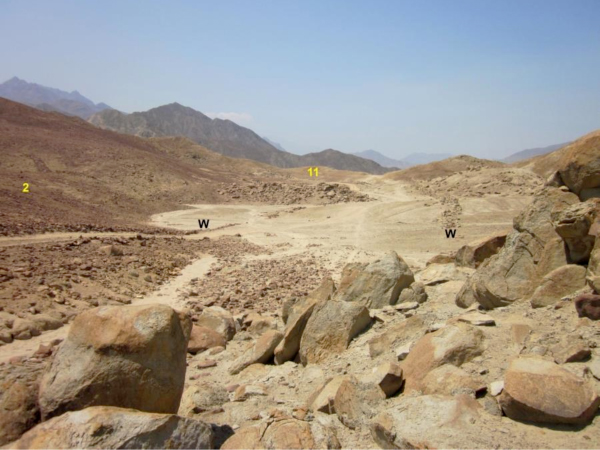
|
Figure 6.
Looking SE across the southern end of the pass towards the (invisible)
Pampa Colorada. W: Walls of the Cupisnique Road; 2: the SE end of Cerro Colorado (above the ‘2’ are possibly some geoglyphs (see video); 11: the location of the possible Tambo (invisible) and other features. Photograph © by Maarten van Hoek, 2015. |
There are at least 15 petroglyph boulders (rocas) that I have labelled OVR-001 to
OVR-015. A 16th boulder (OVR-016), reported by Llosa Giraldo (2011),
was not noticed by us. Those 16 boulders will be briefly described roughly from
north to south. When having more than one decorated panel, capital letters have
been added (for instance OVR-002A etc). All petroglyphs have been manufactured
by superficially pecking away the thin layer of patinated stone. Most images
appear deeply patinated and many could only be distinguished with difficulty.
Therefore there may be more petroglyphs or decorated panels/boulders that may
show up in different or better lighting conditions. Measurements have not been
taken during our photographic survey. Also the bearings of the decorated
surfaces have not been registered, especially as many boulders may have been
disturbed, because this sacred site has been violated by a modern dirt track,
while its north end has been transformed into a modern cemetery, emphasising
(but probably also disturbing) the sacred nature of the spot.
A medium sized boulder with a flat upper surface
bearing a rather clear pattern of lines. One of the lines seems to form a
stepped design, while others may represent the heads of biomorphs (snakes
perhaps). The patination of the petroglyphs is rather bright.
A rather large boulder has three panels. Panel A is a
vertical panel featuring a large complex pattern (a head perhaps?) of the
MSC-Style (the explanation of this acronym is given below). Attached to this
pattern are a possible biomorphic figure and a somewhat brighter but simple
pattern of lines. Panel B is also (near) vertical. It features two large and
almost horizontally arranged and frontally depicted anthropomorphic figures,
both manufactured in outline. The upper figure is incomplete (weathered off or
unfinished). It shows part of the upper body, short arms and an oval head
featuring ears, eyes, two dots for a nose and a simple line for the mouth. It
also seems to bear a ‘strange’ headgear (?). Its right hand touches the other
(complete) anthropomorphic figure. It has also an oval head with similar facial
features, but this time the ears seem to have earrings. Instead of a headgear,
five lines radiate from the upper part of the head, possibly representing hair,
a headgear or even power lines. Its right hand and foot appear on Panel C that
features an imperfect oval ring (the start of a third head?).
This again is a rather large boulder with at least
four decorated panels. Panel A steeply slopes to one side and features a very
much weathered pattern of lines that may well represent a kind of biomorph since
three foot-like or hand-like petroglyphs are part of the design. This design is
very deeply patinated and very hard to see. Panel B is the steeply sloping
surface to the left of Panel A with some very faint and deeply patinated
designs that are extremely hard to decipher. Panel C is to the right of Panel
A. This very small, triangular panel features a set of concentric curved lines.
Panel D is a large, vertical panel that features two sets of patterns made by
straight lines (some of which may be natural). One set possibly depicts a small
biomorphic figure (a llama?).
This large boulder has four decorated panels. Panel A
is almost vertical. Its rough surface shows at least four petroglyphs (and
possibly there are more) that are rather deeply patinated. One of the
petroglyphs may portray a laterally depicted MSC-Style head (Cabeza Cupisnique?). Panel B features a
number of almost invisible lines of which the pattern is indecipherable. Panel
C is also almost vertical and shows a pattern of deeply patinated lines that
might form a bird image and at least on S-shaped spiral. To the right is a
pattern of lines that continues onto Panel D ending in a circular head with
simple dots for eyes and a straight line depicting the mouth. The top of the head
shows a triangular indentation thus forming two triangular (feline?) ‘ears’.
Near the head are some markings (one spiral-like), while further to the right
are two deep (natural or anthropic?) holes (shaped like cupules) that are
enclosed/surrounded by a complex but very faint design of lines that may depict
a biomorph; even an anthropomorph. These deeply patinated holes may have been
incorporated intentionally into the design to represent the eyes of the
purported biomorph/anthropomorph.
A medium sized boulder shows a number of rather bright
petroglyphs near the upper end of an almost vertical panel. Dominating is a set
of three (possibly four) concentric curved lines incorporating a small circle
with central dot. Next to this set is a bright angular U-shape.
The upper surface of a medium sized boulder shows some
very faint petroglyphs including a small circle and a large circle with central
dot.
The vertical surface of this medium sized boulder
shows some short, straight lines.
This large, irregular, eroded boulder has a set of two
concentric ovals (an eye?) and a few indistinct lines/markings.
The upper surface of this small boulder seems to have
an unfinished or weathered-off petroglyph. Only part of the outline of a
possible head and the two ears (?) are visible at the moment.
The smooth upper surface of this small boulder (lying
very close to the modern track through the site) features a design of lines
that possibly represents a biomorph.
The almost vertical side of this medium sized boulder
features a bright oval shape with a dot touching the lower side thus giving the
impression of the MSC-Style eccentric eye. There are some more very indistinct
marking on this panel as well as a (natural) hole that may have a pecked line
around it. This boulder is just north of a low and short, ancient wall that
traverses the modern track at a right angle.
Another medium sized boulder lies on the other
(western) side of the modern track and just south of the low and short, ancient
wall that traverses the modern track. It is the southernmost petroglyph boulder
discovered at this occasion. Its upper surface has some very indistinct lines
(some possibly natural) and a (natural) hole with a rather bright ring around
it.
North of Boulder OVR-011 are three other petroglyph
boulders. An angular boulder of medium size has some very faint lines (one
group forming a pattern) on its steeply sloping and very smooth surface
(partially covered by a large boulder).
This medium sized boulder has an almost invisible
pattern of lines on its upper surface.
This medium sized boulder has an almost invisible
pattern of lines on its almost vertical surface (some of the lines may have
been formed by natural processes).
This is the only boulder reported by Llosa Giraldo
(2011) that we missed during our survey and therefore it may well be located
elsewhere, for instance further south of the low and short, ancient wall that
traverses the modern track; possibly in or near the alleged Tambo (11 in Figure 4). According to the
photos posted by Llosa Giraldo (2011) the boulder is part of a low wall forming
a roughly circular structure.
An important facet of this site, which possibly
explains the linear character of this petroglyph group, has hitherto not been
mentioned. All petroglyph boulders are more or less aligned along a prehistoric
road of probably Cupisnique (Formative Period) origin. Although the factual
association is uncertain (some petroglyphs may be older than the construction
of the road), several of the (now disturbed?) petroglyph boulders may even have
been incorporated into the ancient road on purpose.
A second explanation for the selection of the spot at
El Olivar for petroglyph production certainly has been the availability of
suitable rock surfaces; in this case the deeply patinated, ‘red’ boulders. This
type of red stone is very common in this part of the Andes. I am convinced that
the ancient Andean manufacturers preferred this type of red stone because the
newly made images clearly stood out in sharp contrast with the original,
patinated surface of the stone. In most cases the resulting image was clearly
white on a red background. This is what I would like to call the micro-level of
contrasting colours. Due to weathering illustrative examples do no longer occur
at El Olivar, but Boulder AP3-099 at Alto de Pitis, in the Majes Valley of
southern Peru (Figure 7), is a fine example. Indeed, many images fade or
disappear completely over time. Petroglyphs on Boulder CNG-019 at Cerro Negro
in Chicama (Figure 8) perfectly show the difference between deeply patinated
lines (red arrow) and fresh white lines (yellow arrow - a recently made or
recently re-pecked image?). This red-white contrast proves to be important in
the worldview of many ancient Andean cultures.
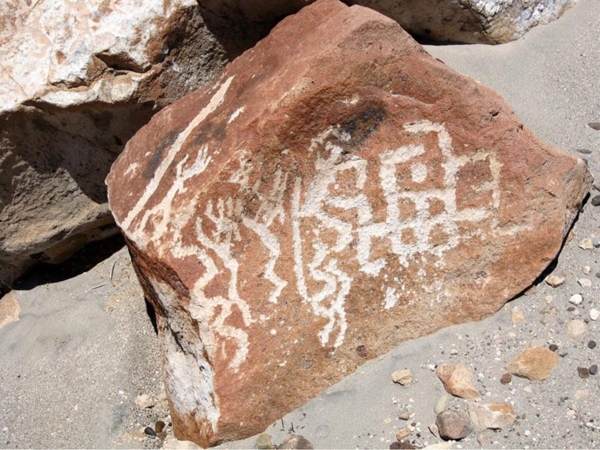 |
|---|
Figure 7. Boulder AP3-099 at Alto de Pitis, in the Majes Valley of
southern Peru.
|
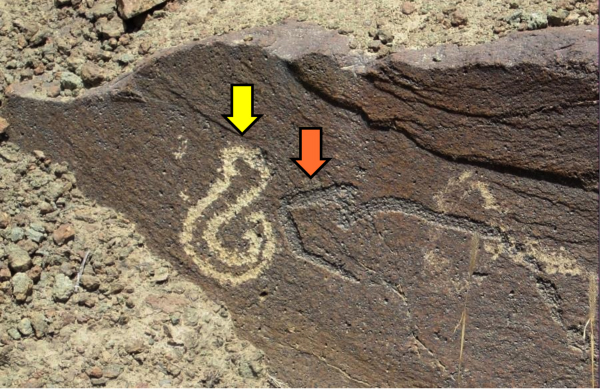 |
Figure 8. Boulder CNG-019 at Cerro Negro in Chicama, northern Peru.
|
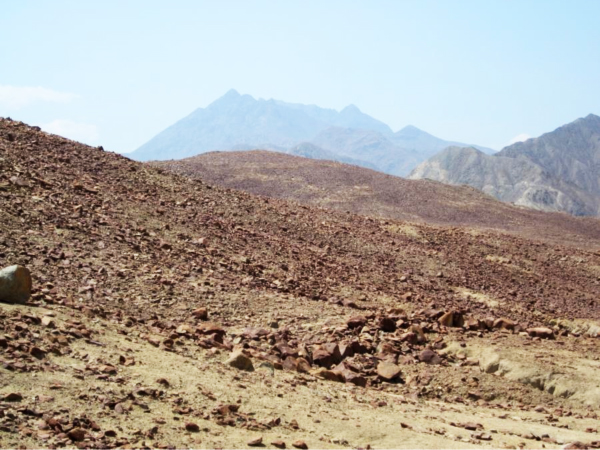 |
|---|
Figure 9. The red SE slopes of Cerro Colorado, looking east.
|
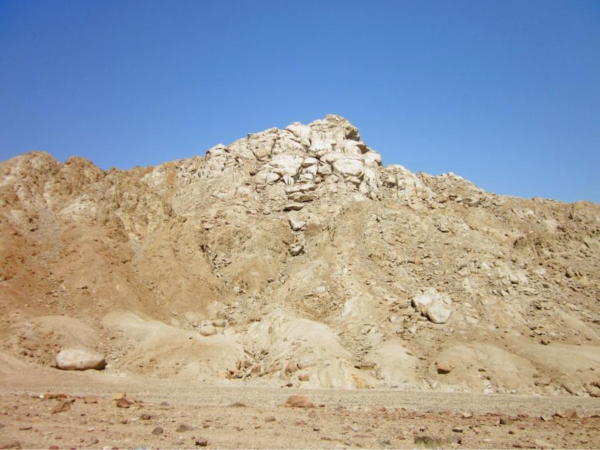 |
Figure 10. The clearly white mountain top of Cerro Cahuacucho, looking
SW.
|
But there is more. The petroglyph site of
El Olivar is located in a small pass (running NW-SE for 1.2 km between the red
hill and the white mountain). To the south, at a point where several ancient
structures are visible (including the possible Tambo; 11 in Figure 6), this pass opens onto the Pampa Colorado
(Red Pampa). To the north this pass directly connects with a large, east-west
running alluvial plain between Cerro Colorado and Cerro San Pedro in which
there is a sharp contrast between the higher parts of the alluvial fans (5 in
Figure 4) and the lower parts of the wide and shallow river bed of Quebrada
Tucushuanca (4 in Figure 4) in which the seasonal waters intermittently flow.
The higher parts consist of deeply red and brown stones (gravel and boulders),
while the dry riverbed comprises white boulders, gravel and sand. The contrast
is most eye-catching (Figure 5; see video).
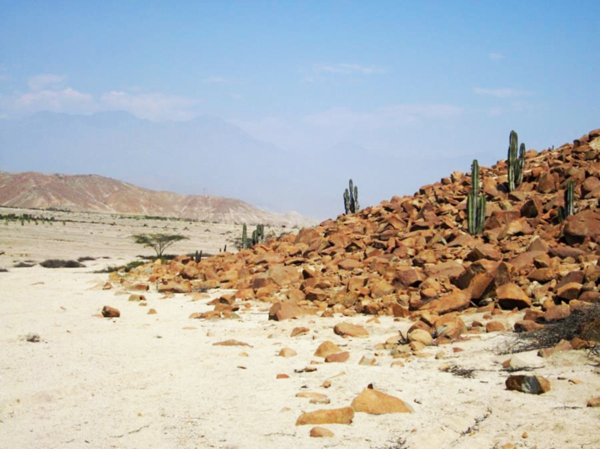 |
|---|
Figure 11. The boulder field of Motocachy Pampa, Ancash, northern Peru,
looking SE.
|
Other red boulders or boulder fields are found near
white, usually dry river beds, like the petroglyph sites of Santa Rita, Cerro Negro, Muralla and Pakra (Figure
12), Pampa
Grande (Fig. 6), Palamenco, Motocachy Pampa, El Vagón, Los Tres Cerritos,
Queneto and of course El Olivar (Figure 4). At other sites red petroglyph
boulders contrast sharply with a backdrop of huge white dunes, like the sites
of Tolón in Jequetepeque (Figure 13) and Queneto and Quebrada de San Juan
(Figure 14) in Virú. Also the contrast between the high-altitude zone of red
stone selected for petroglyph production and the surrounding dark-grey
mountains at Chillihuay in southern Peru is striking.
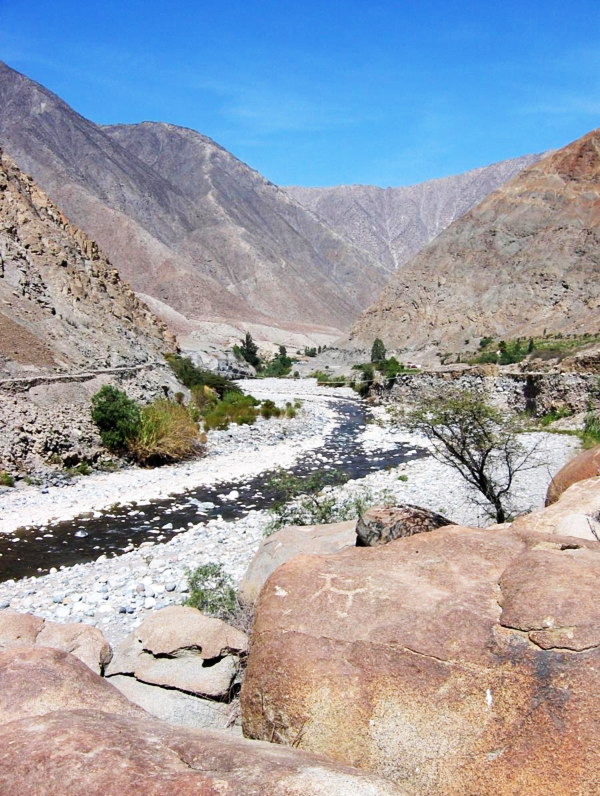 |
|---|
Figure 12. Muralla, bordering the Río Pisco, central Peru, looking SW.
|
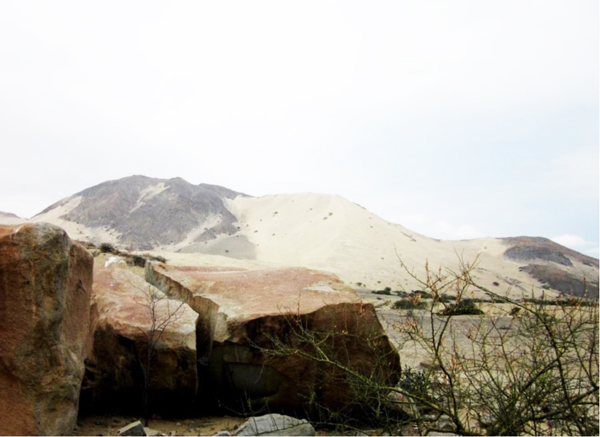 |
| Figure 13. The boulder field of Tolón, northern Peru, looking SW
towards a huge dune on top of Cerro Tira Larga. Photograph © by Maarten van Hoek, 2015. |
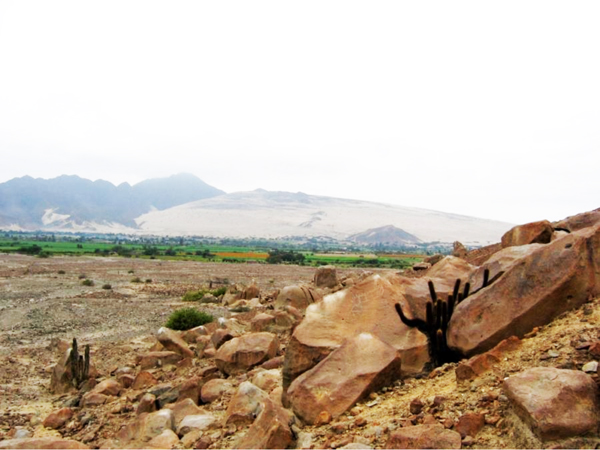 |
| Figure 14. The boulder field of Quebrada de San Juan, northern Peru,
looking SE towards a large dune on Cerro Zaraque. Photograph © by Maarten van Hoek, 2015. |
It is even possible that red stone was especially
selected at a spot where white, snow-capped volcanoes or mountain tops are
visible. This may be the case at the petroglyph sites of La Isla and Santa
Barbara on the Río Loa in northern Chile and, in particular, at Alto de Pitis
on the east bank of the Río Majes in southern Peru. The situation at Alto de
Pitis deserves more attention.
What intrigued me deeply during my surveys in the
Majes Valley of southern Peru were the several contrasting colours that could
be seen at and from Alto de Pitis. Most fascinating and telling is the contrast
between the monotonous grey desert and two small, but most conspicuous Red
Spots in the hill sides opposite Alto de Pitis. The most eye-catching Red Spot
is just above the hamlet of Punta Colorada (Red Spot) (Figure 15). The second
Red Spot is located just above the hamlet of La Candelaria. These two Red Spots
(6.5 km apart) also seem to frame the ‘entrance’ to the enormous rock art
complex of Toro Muerto.
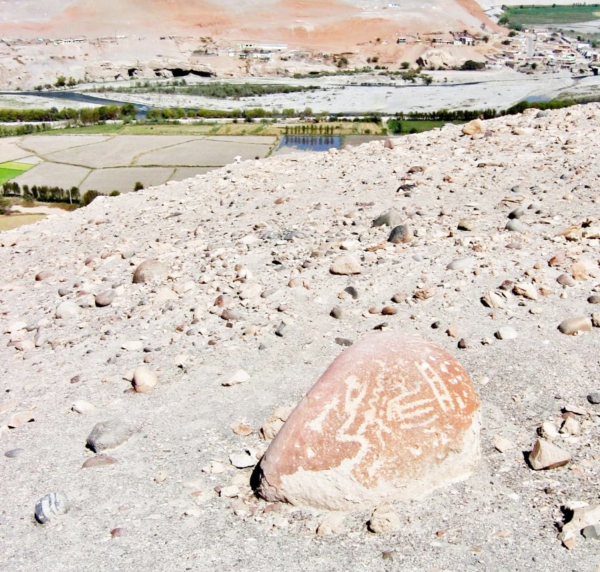 |
|---|
Figure 15. Petroglyph boulder at Alto de Pitis, Valle de Majes,
southern Peru, looking west.
|
It proves that the contrasting colours ‘red’ and
‘white’ were, and still are, important in Andean worldview. Apart from the
initially white petroglyphs on red rock panels and opposing white and red
landmarks, there are more instances in the Andean legacy that emphasise the
importance of (those) contrasting colours. For instance, the Formative Period
Temple Complex of Kuntur Wasi in Cajamarca, northern Peru, features four
impressive and menacing sculptured stone faces in a sunken rectangular Plaza
with two white monoliths and two red monoliths facing each other. The
confined area of the rectangular Plaza unites those four monoliths in a perfect
harmonisation of a cross (Kato 1993: 226-227; Onuki 2008: 209. Dr. Rebecca
Stone-Miller (1995: 40) describes the Black and White Portal of the New Temple
at Chavín de Huántar as examples of duality and complementarity underscored
with natural colour.
Moreover, Amado Quispe, a young shaman and the primary research participant of Dr. Webb stated: For us, yanantin doesn’t focus on the differences between two beings. That is what disconnects them. Instead, we focus on the qualities that brought them together. … One on its own can’t hold everything, can’t take care of everything. Not only are they great together, but they need to be together. … When there is another, it represents extra strength for both. (Webb 2012: 75).
Merging the concept of yanantin with the
rituals of petroglyph production is the next logical step in my line of
reasoning. Although I spoke of ‘red’ and ‘white’ throughout this paper, the
colours do not really matter. In this paper, it is the contrast that
matters. For instance, the intense black and shiny boulders at the petroglyph
site of Parque Diaguita in western Argentina once literally and metaphorically
reflected the same meaningful contrast when symbols were pecked out of the
deeply patinated surface. This contrast has almost completely disappeared at
the moment, but re-appears when observed from a certain angle. Boulder
DIA-W-008 at Parque Diaguita (Figure 16; many more photos available in my video) offers a good example of two
different types of patinated images, the more deeply patinated images are best
visible with reflecting sunlight (Van Hoek 2014b). At Yonán in northern Peru
the petroglyphs have been manufactured on grey-blue panels. Toro Muerto, also
in Peru, has many grey, yellowish and whitish panels. However, freshly made
images are almost invariably much whiter. Yet, I still argue that the red-white
contrast is the most desired and the most meaningful contrast in Andean
worldview.
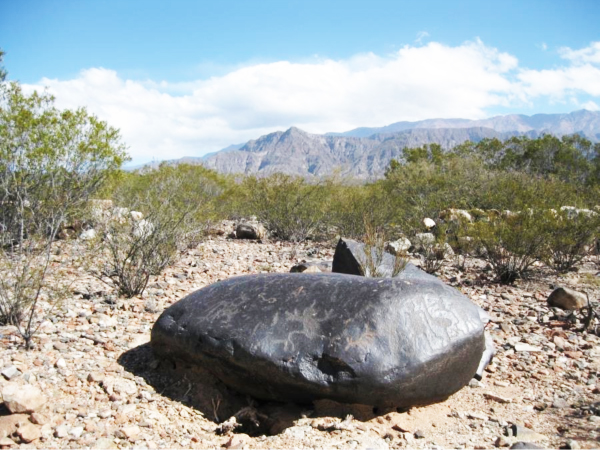 |
|---|
| Figure 16. Boulder DIA-W-008
at the petroglyph site of Parque Diaguita in western Argentina, looking
west. Photograph © by Maarten van Hoek, 2015.
|
Thus, the
ritual of image-making resulted in a bright symbol on a dark background; an
ensemble for which can also be stated: “Not only are they great together, but
they need to be together” (Amado Quispe, in: Webb 2012). The contrasting
colours are not in conflict with each other; on the contrary, they build a
harmonious whole in which the natural qualities of the red stone are connected
with the anthropic meaning of the newly created, white symbol. The red stone is
part of and may be regarded to represent/symbolise Pacha Mama, while the white symbol may represent a message to the
spirits of the Apus. Thus,
simultaneously, the whole picture of
the complementary opposites (red boulder and white image) conveys a message. The white symbol would be meaningless without
the red surface of the stone that supports it and vice versa.
Interestingly, the ancient Andeans applied - without
realising this, of course - the concept of entropy, which - in physics - is a
fundamental part of the second law of thermodynamics. Simply said this concept
reads: the more entropy, the more
disorder and the more probability. Thus, chaos is a more likely situation.
However, also in information-science entropy is a measure of disorder or chaos,
and then it can be read as: the lower the entropy, the less chaos and the more information. An example will
clarify this. A completely white piece of
paper (compare this with the despacho ritual mentioned above) conveys no information; there is no difference; all
parts of the paper are equal. This state of complete lack of information
represents maximum entropy, total chaos or complete disorder. Only when
contrast is added onto the paper (for instance in the form of black letters, a
colour-drawing or a pattern of objects as used in a despacho) the whole (paper and pattern) conveys
information, thus decreasing the entropy or chaos.
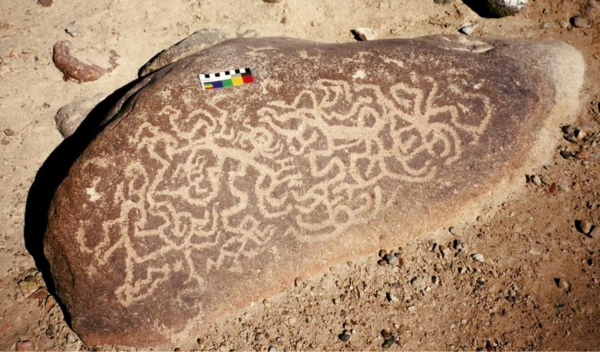 |
|---|
| Figure 17. Boulder MIM-010 at
the petroglyph site of Miculla in southern Peru, looking west. The observant observer may spot at least two zoomorphic figures hidden in the chaos of lines (the brain is trained to look for information). Photograph © by Maarten van Hoek, 2015. |
The Andean physical world is one of the most restless
and active areas on earth. Earthquakes, volcanic eruptions, landslides, tidal
waves, El Niño's, droughts and floods repeatedly confronted Andean societies
with chaos and disorder. On top of that, military forces often invaded (other)
Andean cultures, which added to the chaos and stress. On the other hand, the
natural world supplied (and still supplies) an abundance of seafood and fertile
river valleys (immediately bordered by barren deserts). This strongly
contrasting dualism of negative forces and positive properties shaped the
religious beliefs of almost every Andean society. As a result, an important
property of Andean ritual concerns the concept of maintaining a cosmic order,
which involves mediation of the opposing forces to create a condition of
harmonious balance. However, mediation never resulted in an enduring
equilibrium and disasters occurred, time after time. From an Andean perspective
such disasters happened because of human disregard of the religious tenets,
which disturbed the delicate balance. Then a (part-time) shaman or a
(full-time) priest had to enter the supernatural world in order to mediate the
dualistic forces and to direct the powers to benefit the community.
Consequently, one had to find a way to communicate with both the supernatural
and the common people in a convincing and enduring way.
CONCLUSIONS
El Olivar is a petroglyph site typical for this part
of the Andes. Itself being a sacred site, it is associated with religious
centres (Huacas) in a fertile river
valley and simultaneously with infrastructure that crosses the barren desert
connecting lush river valleys (although there is no scientific evidence yet
that the art is indeed contemporary with either the Huacas or the infrastructure). But it is obvious that El Olivar is
located on a crossroads of horizontally and vertically organised traffic of
goods and people and thus also of religious concepts. The site, the
(petroglyph) rocks and the images, all were important and revered in ancient times.
I would like to thank Mrs Giuliana Melendez and
especially Mrs Lucha Mendiola Lomparte, both from Casma, for making it possible
for us to explore the Casma area and especially the Sechín valley. Without the
help and determination of Mrs Lucha Mendiola Lomparte and the much appreciated
assistance of several locals from El Olivar we would never have been able to
survey El Olivar. I am also indebted to Mrs Meg Beeler for her permission to
use information from her web site, and to Dr. David Johnson and Dr. Carlos
Zapata Benites for providing useful information about Pampa
Colorada. As ever I thank my wife Elles for her assistance in the field and her
support at home.
![]()
—¿Preguntas, comentarios? escriba a: rupestreweb@yahoogroups.com—
Cómo citar este artículo:
En Rupestreweb, http://www.rupestreweb.info/yanantin.html
2015
REFERENCIAS BIBLIOGRÁFICAS
(all hyperlinks functioning in March 2015)
Armstrong, G. 1990. Symbolic
arrangement and communication in the Despacho. PhD. Thesis. University of
St. Andrews, Scotland.
Van
Hoek, M. 2006. Toro Muerto, Perú. Posibles alteraciones prehistóricas en detalles
de petroglifos. In: Rupestreweb.
In: TRACCE, On-line Rock Art
Bulletin; and in: Rupestreweb.
